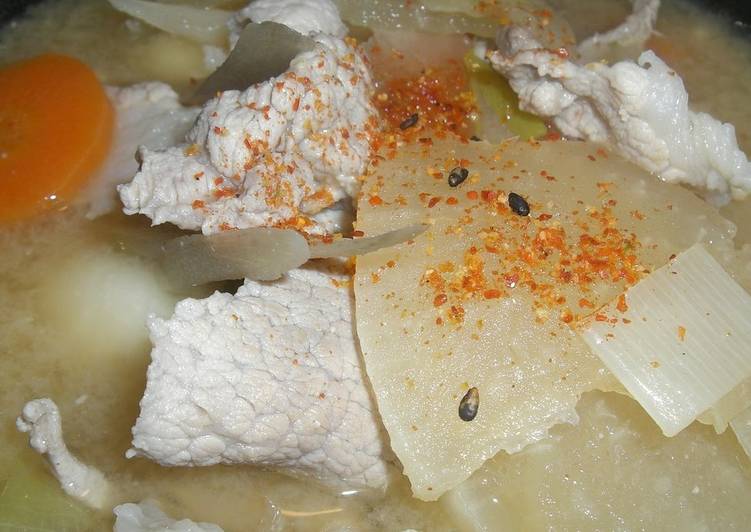
Hello everybody, it is Brad, welcome to my recipe site. Today, I’m gonna show you how to make a distinctive dish, professional-tasting 'tonjiru' pork miso soup. It is one of my favorites food recipes. For mine, I will make it a little bit tasty. This is gonna smell and look delicious.
Professional-Tasting 'Tonjiru' Pork Miso Soup is one of the most popular of current trending meals in the world. It’s easy, it’s quick, it tastes yummy. It’s appreciated by millions daily. Professional-Tasting 'Tonjiru' Pork Miso Soup is something that I’ve loved my whole life. They are fine and they look fantastic.
Tonjiru is a savory pork and vegetable miso soup with an excellent source of B vitamins, fiber, and minerals and it's nourishing and oh-soul-fulfilling! As an Amazon Associate I earn from qualifying purchases. Tonjiru is a savory miso soup with pork and root vegetables.
To begin with this particular recipe, we have to first prepare a few components. You can have professional-tasting 'tonjiru' pork miso soup using 12 ingredients and 8 steps. Here is how you can achieve it.
The ingredients needed to make Professional-Tasting 'Tonjiru' Pork Miso Soup:
- Prepare 150 grams Thinly sliced pork
- Take 1/2 Burdock root
- Get 5 cm Daikon radish
- Take 1/2 Carrot
- Get 1 Leek
- Get 5 Frozen taro root
- Get 1 Aburaage, konnyaku
- Prepare 1 Miso
- Prepare 1 tbsp Sake
- Take 1 tbsp Soy sauce
- Get 1 Dashi powder
- Get 2 to 3 drops Sesame oil
Tonjiru (or Butajiru) is a kind of Miso Soup with pork and a lot of root vegetables such as Gobo (burdock root) and carrot. Even though it is a Miso soup, Tonjiru tastes very different from ordinary Miso Soup. Tonjiru has a distinct pork flavor and strong taste from Gobo. Miso soup in Japan is perhaps one of the most popular side dishes because it goes well with virtually every type of Japanese cuisine.
Steps to make Professional-Tasting 'Tonjiru' Pork Miso Soup:
- Cut the vegetables (I cut the daikon radish into quarter-rounds, sliced the carrot, green onions into chunks, and shredded the burdock). Cut the pork into bite-sized pieces.
- Put all the vegetables in cold water (about a liter) into a saucepan, and turn on the heat to high. When it comes to a boil, skim the scum from the surface and turn down the heat to low.
- Add half of miso and sake, cover with a lid and continue to simmer until the vegetables have soften.
- While the vegetables are cooking, prepare the pork. When the water comes to the boil, turn it off, and add the pork for about 15 seconds. Drain.
- Once the vegetables are cooked through, put the pork and dissolve the remaining miso. Add the soy sauce to taste. If you like, add a little dashi powder for a boost of flavor, but It's also fine without it.
- Drop a few drops of sesame oil into a ladle and mix into the soup. Take care not to use too much sesame oil. When the pork is cooked through, it's ready to serve.
- ※I always have taro root stocked in my freezer, so we use them frozen, but if you are using fresh ones, peel them first.
- ※Sometimes my daughter asks me to replace the taro root with Japanese sweet potato. The soup becomes slightly sweet, but it's just as tasty.
In fact, you can power it up by making a butajiru (also called tonjiru) by adding pork and other ingredients. The extra umami that comes from the meat makes the butajiru. The traditional tonjiru is made with tofu, miso, and dashi stock, combines pork with vegetables It has very little taste; the common variety tastes vaguely like salt. It is valued more for its texture than flavor The whole tonjiru dish is very comforting in this cold winter weather. Make a hearty and delicious tonjiru soup with our authentic and easy-to-follow Japanese recipe and video and get ready for the applause.
So that’s going to wrap it up for this exceptional food professional-tasting 'tonjiru' pork miso soup recipe. Thanks so much for your time. I’m confident you can make this at home. There’s gonna be more interesting food in home recipes coming up. Remember to bookmark this page in your browser, and share it to your loved ones, friends and colleague. Thank you for reading. Go on get cooking!


